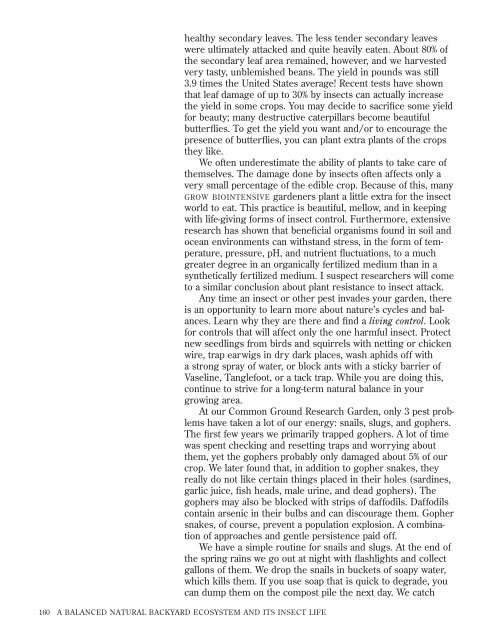How to Grow More Vegetables : And Fruits, Nuts ... - Shroomery
How to Grow More Vegetables : And Fruits, Nuts ... - Shroomery
How to Grow More Vegetables : And Fruits, Nuts ... - Shroomery
Create successful ePaper yourself
Turn your PDF publications into a flip-book with our unique Google optimized e-Paper software.
healthy secondary leaves. The less tender secondary leaves<br />
were ultimately attacked and quite heavily eaten. About 80% of<br />
the secondary leaf area remained, however, and we harvested<br />
very tasty, unblemished beans. The yield in pounds was still<br />
3.9 times the United States average! Recent tests have shown<br />
that leaf damage of up <strong>to</strong> 30% by insects can actually increase<br />
the yield in some crops. You may decide <strong>to</strong> sacrifice some yield<br />
for beauty; many destructive caterpillars become beautiful<br />
butterflies. To get the yield you want and/or <strong>to</strong> encourage the<br />
presence of butterflies, you can plant extra plants of the crops<br />
they like.<br />
We often underestimate the ability of plants <strong>to</strong> take care of<br />
themselves. The damage done by insects often affects only a<br />
very small percentage of the edible crop. Because of this, many<br />
GROW BIOINTENSIVE gardeners plant a little extra for the insect<br />
world <strong>to</strong> eat. This practice is beautiful, mellow, and in keeping<br />
with life-giving forms of insect control. Furthermore, extensive<br />
research has shown that beneficial organisms found in soil and<br />
ocean environments can withstand stress, in the form of temperature,<br />
pressure, pH, and nutrient fluctuations, <strong>to</strong> a much<br />
greater degree in an organically fertilized medium than in a<br />
synthetically fertilized medium. I suspect researchers will come<br />
<strong>to</strong> a similar conclusion about plant resistance <strong>to</strong> insect attack.<br />
Any time an insect or other pest invades your garden, there<br />
is an opportunity <strong>to</strong> learn more about nature’s cycles and balances.<br />
Learn why they are there and find a living control. Look<br />
for controls that will affect only the one harmful insect. Protect<br />
new seedlings from birds and squirrels with netting or chicken<br />
wire, trap earwigs in dry dark places, wash aphids off with<br />
a strong spray of water, or block ants with a sticky barrier of<br />
Vaseline, Tanglefoot, or a tack trap. While you are doing this,<br />
continue <strong>to</strong> strive for a long-term natural balance in your<br />
growing area.<br />
At our Common Ground Research Garden, only 3 pest problems<br />
have taken a lot of our energy: snails, slugs, and gophers.<br />
The first few years we primarily trapped gophers. A lot of time<br />
was spent checking and resetting traps and worrying about<br />
them, yet the gophers probably only damaged about 5% of our<br />
crop. We later found that, in addition <strong>to</strong> gopher snakes, they<br />
really do not like certain things placed in their holes (sardines,<br />
garlic juice, fish heads, male urine, and dead gophers). The<br />
gophers may also be blocked with strips of daffodils. Daffodils<br />
contain arsenic in their bulbs and can discourage them. Gopher<br />
snakes, of course, prevent a population explosion. A combination<br />
of approaches and gentle persistence paid off.<br />
We have a simple routine for snails and slugs. At the end of<br />
the spring rains we go out at night with flashlights and collect<br />
gallons of them. We drop the snails in buckets of soapy water,<br />
which kills them. If you use soap that is quick <strong>to</strong> degrade, you<br />
can dump them on the compost pile the next day. We catch<br />
160 A BALANCED NATURAL BACKYARD ECOSYSTEM AND ITS INSECT LIFE












